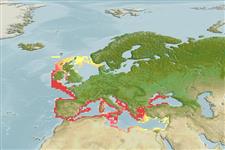Common names from other countries
Environment: milieu / climate zone / depth range / distribution range
Écologie
; profondeur 125 - 200 m (Ref. 2754). Tropical, preferred 16°C (Ref. 107945); 61°N - 30°N, 11°W - 36°E
Northeast Atlantic, the Mediterranean and the Black Sea. Introduced to the Arctic, Indian and Pacific Oceans.
Length at first maturity / Taille / Poids / Âge
Maturity: Lm ? range ? - ? cm Max length : 16.5 cm SHL mâle / non sexé; (Ref. 109255)
Description synthétique
Morphologie
The shell lacks radiating ridges containing three small teeth below the beak. The exterior is often bluish black with the interior portion being dull blue (Ref. 310).
Found in warmer waters (Ref. 95344). Occurs in quiet waters and lives lower in the intertidal zone attached to rock substrates (Refs. 310, 125090). Inhabits muddy and sandy bottoms (Ref. 125090). Smaller individuals move to the outer edge of the colony (Ref. 310). Feeds on a variety of phyto- and zooplankton (Ref. 112108).
Life cycle and mating behavior
Maturité | Reproduction | Frai | Œufs | Fécondité | Larves
Members of the class Bivalvia are mostly gonochoric, some are protandric hermaphrodites. Life cycle: Embryos develop into free-swimming trocophore larvae, succeeded by the bivalve veliger, resembling a miniature clam.
Demir, M. 2003. (Ref. 2754)
Statut dans la liste rouge de l'IUCN (Ref. 130435)
statut CITES (Ref. 108899)
Not Evaluated
Not Evaluated
Utilisations par l'homme
Pêcheries: commercial
FAO - Aquaculture: production, species profile; pêcheries: landings, species profile | FishSource | Sea Around Us
Outils
Sources Internet
Estimates based on models
Preferred temperature
(Ref.
115969): 5.5 - 18, mean 11 (based on 176 cells).
Résilience
Haut, temps minimum de doublement de population inférieur à 15 mois (K=0.1-1.82).
Prior r = 0.50, 95% CL = 0.33 - 0.75, Based on 2 data-limited stock assessments.
Vulnérabilité
Low vulnerability (10 of 100).
